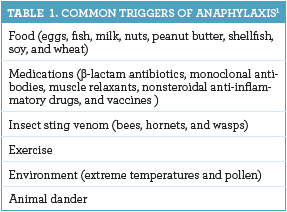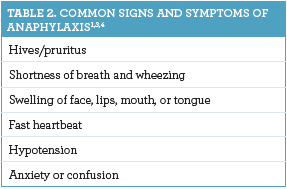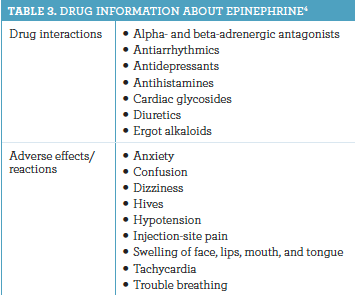Publication
Article
Pharmacy Times
Prepare for Anaphylaxis in School-Aged Children
Author(s):
Pharmacists can educate caregivers and patients about proper epinephrine delivery technique.
As everyone prepares to head back to school, it is important for all to be prepared for crises that can arise.
Anaphylaxis is a life-threatening health condition that can be induced by several triggers (see table 1).1 Prompt epinephrine administration can reduce morbidity and mortality.2 Children with severe allergic conditions must have immediate access to epinephrine for life-saving emergencies.

Epinephrine is a nonselective alpha- and betaadrenergic agonist that can reverse anaphylaxis and serious allergic reactions (see table 2).1,3,4 It is available in various formulations such as auto-injectors, injectable solutions, and prefilled syringes, with more formulations on the horizon. An auto-injector and a prefilled syringe both contain a single ready-to-use dose of epinephrine.

Epinephrine auto-injectors have been in short supply since May 2018. This shortage has led to a surge in the use of epinephrine prefilled syringes.5,6
Epinephrine increases vascular permeability and lessens the vasodilation experienced during anaphylaxis.4 The medication also alleviates bronchospasms and dilates bronchial smooth muscle.4 It comes in 2 formulations: 0.15 mg, for patients who weigh 33 to 66 lb (15 to 30 kg); and 0.3 mg, for patients who weigh 66 lb (30 kg) or more.3,4 Although epinephrine has no known contraindications, several drug classes can interact with it (see table 3).4 Caregivers and physicians should carefully observe patients receiving epinephrine who are taking medications within these drug classes concomitantly for the potential development of severe adverse effects and reactions.1,4

Prominent warnings indicate that epinephrine use does not replace immediate medical care. Pharmacists need to advise patients to check the syringe solution’s turbidity and discard and replace the syringe if the solution is cloudy with or without particulates.3 The prefilled syringe comes in a convenient 2-pack carrying case with a safety guard to encapsulate the needle after use.
An important distinction between epinephrine auto-injectors and prefilled syringes is that patients must manually insert the prefilled syringe needle and push down the plunger to administer the medication.4 Auto-injectors, on the other hand, inject the substance automatically.
SPECIAL PATIENT POPULATIONS
Pharmacists should note warnings about several patient populations. For pediatric patients, the Centers for Disease Control and Prevention recommends injecting epinephrine into the outer thigh until 2 years of age.7 After that age, when the deltoid muscle is more developed, parents or patients can inject it into the deltoid muscle or outer thigh.7 \
Few studies have examined the use of epinephrine in patients who are pregnant.4
Older patients should use epinephrine cautiously, because of their greater risk for adverse effects.4
Larger amounts of subcutaneous fat tissue associated with obesity create difficulty in establishing an effective dose of epinephrine for emergencies. Epinephrine auto-injector needles are often too short for patients with obesity7,8 and, in emergency situations, intravenous administration of epinephrine in hospital settings is deemed safer.7 Investigators have considered formulating higher doses of epinephrine and longer needles for patients with obesity, but clinical studies are needed.7
Patients with diabetes, heart disease, hyperthyroidism, and Parkinson disease should use epinephrine cautiously, as they can experience worsening symptoms.4
STABILITY, STERILITY, AND SYRINGES
Lack of correct use and response are the 2 most common obstacles caregivers and patients face, which can lead to fatal anaphylactic reactions.9 Health care professionals must explain directions to caregivers and patients regarding the proper use of epinephrine devices.1,4
Epinephrine prefilled syringes cost less than epinephrine auto-injectors, making the product more accessible to patients. 10
Auto-injectors and prefilled syringes should not be stored in the refrigerator or in a vehicle’s glove compartment.3 They should not be exposed to extreme temperatures or light, as these conditions can affect the drug’s potency.3
Although epinephrine has a short duration of action, it is stable and sterile in syringes for up to 3 months.10 Patients should replace the syringe before it expires to ensure that an active drug is administered.2
CONCLUSION
Health care professionals play an important part in emergency preparedness related to anaphylaxis. Pharmacists can educate caregivers and patients about anaphylaxis prevention and reinforce proper epinephrine delivery techniques. Providing patients with pertinent knowledge can help reduce morbidity- and mortality-related events.
Ariana Hawkins is a PharmD candidate at the University of Connecticut School of Pharmacy in Storrs.
REFERENCES
- First aid—anaphylaxis. Mayo Clinic. February 6, 2018. Accessed July 28, 2020. https://www.mayoclinic.org/first-aid/first-aid-anaphylaxis/basics/art-20056608
- Ratanaprug C, Srisuwatchari W, Jirapongsananuruk O, Visitsunthorn N, Pacharn P. Carrying rates of epinephrine devices in children with food-induced anaphylaxis. Asia Pac Allergy. 2019;9(2):e12. doi:10.5415/apallergy.2019.9.e12
- An epinephrine prefilled syringe (Symjepi) for anaphylaxis. JAMA. 2019;321(13):1306-1307. doi:10.1001/jama.2019.0898
- Symjepi—epinephrine injection. Prescribing information. Sandoz, Inc; 2019. Accessed July 28, 2020. https://dailymed.nlm.nih.gov/dailymed/drugInfo.cfm?setid=b1c6a201-4f23-489f-9fcaf8c82bb9fa58
- Current and resolved drug shortages and discontinuations reported to FDA. FDA. May 9, 2018. Accessed July 28, 2020. https://www.accessdata.fda.gov/scripts/drugshortages/dsp_ActiveIngredientDetails.cfm?AI=Epinephrine%20Injection,%20Auto-Injector&st=c&tab=tabs-1
- Epinephrine auto-injectors. American Society of Health-System Pharmacists. July 23, 2020. Accessed July 28, 2020. https://www.ashp.org/Drug-Shortages/Current-Shortages/Drug-Shortage-Detail.aspx?id=420
- Brown JC. Epinephrine, auto‐injectors, and anaphylaxis: challenges of dose, depth, and device. Ann Allergy Asthma Immunol. 2018;121(1):53‐60. doi:10.1016/j.anai.2018.05.001
- Moss J, Jani Y, Edwards B, Tomlin S, Rashed AN. Pharmacokinetic and pharmacodynamic evidence of adrenaline administered via auto-injector for anaphylactic reactions: a review of literature. Br J Clin Pharmacol. Published online June 19, 2020. doi:10.1111/bcp.14438
- Prince BT, Mikhail I, Stukus DR. Underuse of epinephrine for the treatment of anaphylaxis: missed opportunities. J Asthma Allergy. 2018;11:143-151. doi:10.2147/JAA.S159400
- Moss RB. Anaphylaxis: getting to the point (and price) of diagnosis and treatment. J Asthma Allergy. 2018;11:109-110. doi:10.2147/JAA.S170650







